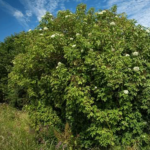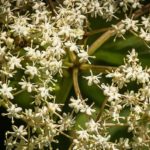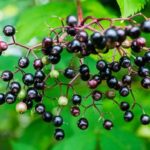Tree for June – The Elder
The Elder
Sambucus nigra

If you are driving along a road and spot a raggedy bit of hedge, like a car has been through it, it’s probably an Elder bush. This much maligned, scruffy, almost messy, indigenous tree can be seen all over our countryside and towns. At this time of the year, in late May and June, it is in full bloom. The blossoms are saucer shaped clusters of tiny, white lacy flowers, abundant all over this messy plant. These clusters of flowers are popular with responsible foragers, for making Elderflower cordial, sorbets, champagne and other recipes

In Winter this scrubby looking tree with its untidy grey, brown, corky furrowed bark has little to offer aesthetically, but from now on, with its rich cover of green leaves and abundance of white blossoms, it develops into this beautiful bride of the countryside. Later in Autumn, each tiny flower develops into a deep purple black berry, again favoured by foragers for Elderflower wine

It flourishes in damp, dank unfavoured areas, often near badger and fox sets whose occupants eat the berries and disperse the seeds. It was once thought that planting an Elder close to a house would ward off the devil. Indeed if you can recall the painting ‘The Hay Wain‘ by Constable, you will remember that there is an Elder Tree right beside the cottage, on the left hand side of the picture
A mature Elder Tree will grow up to 15 metres and live up to 60 years. Elder wood is hard and yellow. Most of its branches are hollow with a pithy centre. In the past it was used for making whistles and bellow nozzles, as well as bowls and spoons
It was a great source for natural dyes. Blue and purple dyes came from the berries and once was used in the colours of Harris Tweed, whilst the leaves give yellow and green and the bark grey and black dyes. A very versatile, abundant, native tree
Athene English